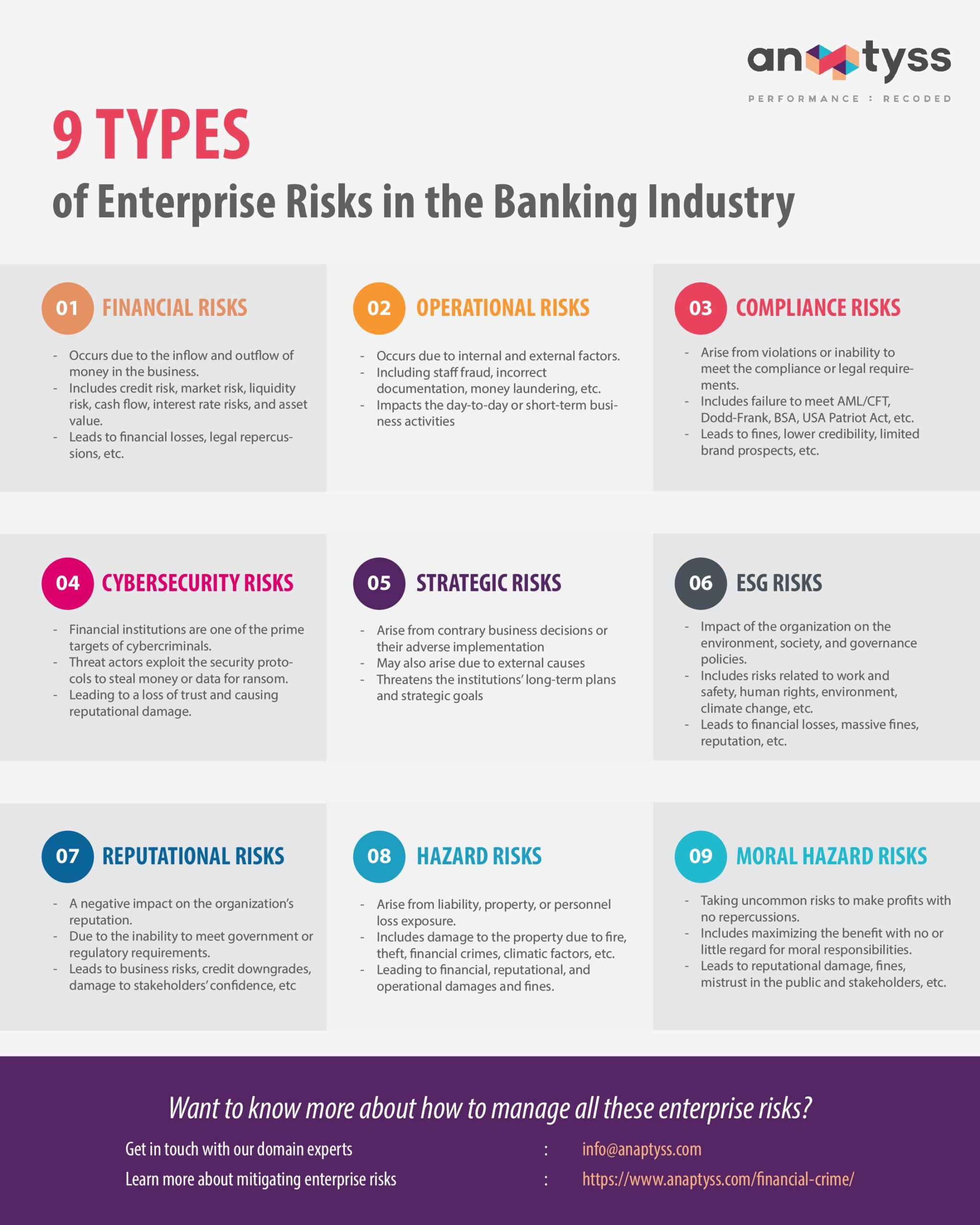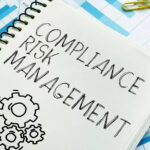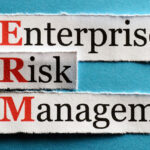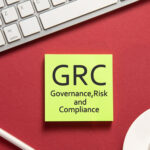In this blog, we dive into the comprehensive realm of Enterprise Risk Management (ERM), exploring various types of risks that financial institutions face, from financial and operational risks to ESG and reputational risks. Discover how Anaptyss employs a preemptive and domain-centric approach to help banks effectively manage these risks, ensuring compliance and safeguarding their business.
Enterprise risk management refers to the process and systems in place to identify the risks and provide solutions to manage risks and reduce their adverse outcomes.
Enterprise risks do not come into play when something goes wrong. They always exist throughout the business cycle. Thus, it’s critical for banks or financial institutions to know the types of enterprise risks they are exposed to and include them in their enterprise risk management (ERM) process.
1. Financial Risks
Banks and financial institutions may experience financial risks and consequences that may occur due to the inflow and outflow of money in the business or the effect of market forces on the financial assets or liabilities that can lead to sudden financial losses.
Financial risks include credit risk, market risk, liquidity risk, cash flow, interest rate risks, and asset value that provide a holistic view of the financial and debt status of the bank or institution. Credit risk is one of the major risks for banks that occurs when the borrower fails to meet the payment obligations or defaults on the principal or interest payments of a loan or mortgage.
While banks are not protected from financial risks due to their nature of business, they can lower their risk exposure by providing loans to parties or borrowers with good credit scores, history, transactions, or backup loans with collateral.
2. Operational Risks
Operational risks result from failed or inadequate internal processes, people, systems, or external events. These risks can impact the day-to-day or short-term business activities and may occur due to both internal and external factors which includes,
- Non-compliance with the banking rules, laws, and regulatory requirements or internal guidelines
- Staff or employee fraud
- Inadequate documentation or incorrect documentation procedures
- Infrastructure or technological failure
- Product or service launch without adequate operational support
- Adverse legal judgments or government policies
- Outsources or third-party activities
- Fire, theft, or natural disaster
- Financial crimes, such as Money laundering, fraud, etc.
3. Compliance Risks
These risks refer to violations of compliance or legal requirements due to financial institutions’ inability to meet the rules, regulations, procedures, standards, and financial crime compliances, such as anti-money laundering, countering financing for terrorism (AML/CFT), Dodd-Frank, BSA, USA Patriot Act, OFAC sanctions, etc.
The risk can expose the financial institutions to violation of contracts, fines by regulators, reduced market value, limited business opportunities, and loss of reputation.
Compliance risk exposes the financial institution to violation of contracts, paying fines, making damage payments, etc. These risks can also result in a weakened brand, lower credibility, and franchise value, limit business prospects, and possibility for expansion.
4. Cybersecurity Risks
Financial institutions are one of the prime targets for many state-sponsored and financially motivated threat actors who exploit the security protocols in digital banking to steal customer data and money. Phishing attacks, trojans, ransomware, spoofing, etc. are some of the cybersecurity risks that banks need to deal with to protect digital information private and safe from theft, misuse, and unauthorized access.
Ransomware is one of the major threats to banks where attackers encrypt the data in exchange for ransom. It is estimated that 90% of financial institutions have faced ransomware attacks in 2022.
In addition, cybersecurity risks can also lead to reputational damage if a security incident takes place.
5. Strategic Risks
Strategic risks arise from contrary business decisions or their adverse implementation. These risks may also arise due to external causes that can lead to a change in the business decision or the direction of the business. These risks threaten the institutions’ long-term plans and strategic goals, which are critical to future success.
Strategic and operational risk are often confused with each other, however, there’s a major difference between the two. Below are some examples of the strategic risk that can derail an organization from achieving its goals,
- Change in the senior management or leadership
- Unsuccessful mergers or acquisitions
- Problems with stakeholders
- Failure to adapt to keep up with the competitors due to changing environment
- Industry changes, such as the shift in customer expectations
- Launch of new product or service
Any strategic decision made by the board or senior management has the potential risk of not working out.
6. Environmental, Social, and Governance (ESG) Risks
Environmental, social, and governance risks or ESG risks include risks related to climate change adaptation and mitigation, working and safety conditions, anti-bribery and corruption practices, regard for human rights, environmental management practices, and compliance with the pertaining laws and regulations.
Environmental risks refer to the impact of the organization on the environment, such as greenhouse emissions, carbon footprint, water usage, waste disposal, etc.
Social risks in ESG include workplace conditions, including safety, wage equality, human rights violations, data privacy, etc.
Governance risks include business operations and governing policies, such as transparency, diversity, corruption and fraud prevention, integrity, ethics, etc.
These risks can affect the bank or financial institution’s reputation and financial position and operational performance. Every organization, regardless of its industry or size, remains vulnerable to the ESG risks that can lead to,
- Financial losses from ESG investors
- Socially-conscious customers and employees
- Violation of laws leads to massive fines
ESG risk evaluation can help the senior management take informed decisions based on the impacts of climate change, emerging regulations, and guidelines.
7. Reputational Risks
Reputational risk refers to a negative impact on the organization’s reputation. Banks’ inability to meet government or regulatory requirements, ineffective service or after-sales service, losing customers’ data, unethical employee behavior, mismanagement of customer records, etc. can damage the financial institutions’ reputation and stakeholder confidence which can lead to business risks and credit downgrade.
Similarly, banks’ failure to evaluate the borrowers and providing large insecure loans leading to fraud can also cause mistrust in the bank’s controls and checks.
8. Hazard Risks
Hazard risks arise from liability, property, or personnel loss exposure. These risks are generally associated with the health and safety of the customers and employees. Hazard risks include damage to the property due to fire, theft, financial crimes, climatic factors, etc. The majority of hazards pose a potential possibility of harm. Yet, once the risk is present, it may result in an emergency.
9. Moral Hazard Risk
Moral hazard refers to a situation wherein a party in a contract lacks the incentive to safeguard the stakeholder interests against financial risks due to misleading information concerning assets, liabilities, investments, and credit capacity.
In banking, moral hazard means taking uncommon risks or decisions to make profits before the contract settles. Moral hazard risks arise due to a lack of incentives or perceived obligations to establish safeguards for countering financial risks and inadequate repercussions for risky or bad corporate behavior. These decisions are often based on considerations that maximize the benefit with no or little regard for moral responsibilities.

Managing Enterprise Risks with a Preemptive & Domain-Centric Approach
A robust enterprise risk management framework (EMRF) can help banks assess, identify, and mitigate all types of risks, meet regulatory requirements, and avoid hefty fines.
As a strategic partner, Anaptyss helps banks with real-world, tailored solutions such as domain-centric risk advisory, ERM framework, technology solutions, and implementation expertise based on the multi-disciplinary enterprise risk management approach.
Anaptyss has helped financial institutions address critical risks, including credit risks, market risks, financial crime risks, operational risks, strategic risks, hazards, etc., safeguarding the business.
Interested in more specific guidance for Enterprise Risk Management and compliance? Write to us: info@anaptyss.com.


















